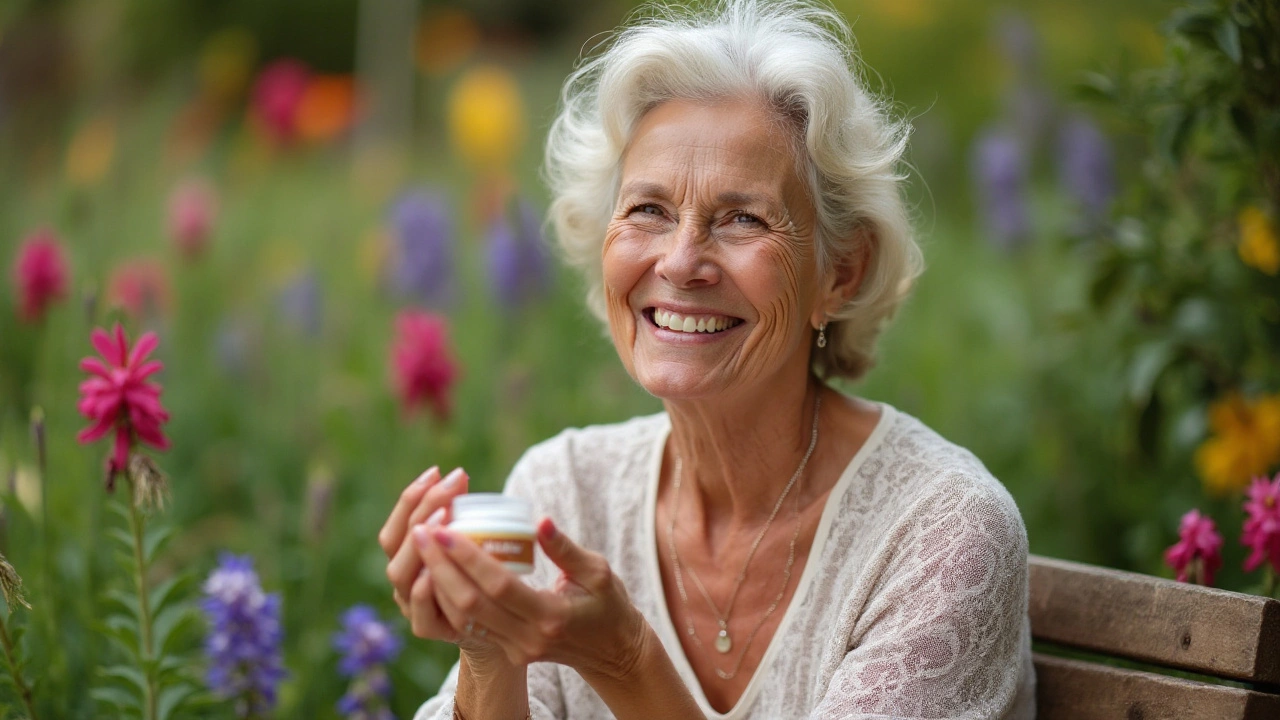As the years roll by, our skin starts to reveal the stories of our age. You might notice that your once firm skin isn’t quite what it used to be — and that’s perfectly normal. While we can’t hit the rewind button on aging, the good news is there are a myriad of ways to rejuvenate and firm up sagging skin, giving it a new lease on life.
Aging causes our skin to lose collagen and elastin, two key proteins responsible for skin's firmness and elasticity. Many find solace in knowing that treating sagging skin doesn't always require a trip down the cosmetologist's chair, thanks to a host of available options. This journey to resilient skin involves understanding the underlying causes, incorporating effective skincare products, considering non-invasive treatments, and embracing healthy lifestyle choices.
This article takes you through practical, science-backed strategies to help turn back the clock on skin sagging. From the right creams and serums to mindful adjustments in your daily routine, it’s time to rediscover the joy of skin that feels as youthful as your spirit.
- Understanding Why Skin Sags
- Lifestyle Changes for Firmer Skin
- Topical Treatments and Ingredients
- Innovative Non-Surgical Procedures
- The Role of Diet and Hydration
- Maintaining Results Over Time
Understanding Why Skin Sags
Aging isn't just about counting candles on your birthday cake; it's an intricate process that quietly takes place beneath your skin's surface. As the years advance, you may notice a marked difference in your skin’s texture and tautness. This journey into skin’s natural progression requires a peek into the layers of the epidermis and dermis, where the remarkable structures known as collagen and elastin reside. These proteins act as the scaffolding for your skin, providing it with that lovely bounce and firmness we often take for granted in our youth. When production slows, your skin begins its gentle sag, a change most evident around the jawline, cheeks, and eyes.
A major player in the sagging process is collagen depletion. After the age of 20, a person produces about 1% less collagen in the skin each year. This decline is significant because collagen fibers form the bulk of the connective framework in skin, giving it structure. Moreover, elastin, another crucial protein, weaves an elastic meshwork that allows skin to snap back into place after being stretched. However, with age, elastin fibers become less resilient, contributing substantially to sagging. The natural loss of these proteins isn’t the only factor. External elements like UV exposure from the sun’s rays can accelerate deterioration through a process called photoaging, leading to deeper wrinkles and more pronounced sagging. A striking quote from the American Academy of Dermatology outlines that, "Ultraviolet radiation speeds the natural aging process in your skin, leading to bruising, leathery texture, and, yes, sagging."
"The cumulative impact of environmental factors, such as pollutants and lifestyle choices, can exacerbate the skin's natural aging process," says a renowned dermatologist.
Hormonal changes, especially around menopause, also play a crucial role. Estrogen is vital for maintaining skin thickness and elasticity, so its decrease naturally influences skin’s suppleness. Suddenly, the once robust battle against gravitational pull seems unnecessarily brutal. A lesser-known fact is that repetitive facial movements over the years, whether it be smiling, squinting, or frowning, can weaken facial connective tissue, contributing to skin sagging. Another important element to consider is the effect of oxidative stress, which results from the imbalance between free radicals and antioxidants in the body. The onslaught of free radicals can damage cells, accelerate aging, and lead to a loss of skin firmness.
Analyzing genetic predispositions also offers insight. Some are naturally gifted with more resilient skin, while others notice sagging prematurely. This is because genes contribute to your skin’s basic structure and its ability to regenerate. And yet, all is not lost in this skin saga. While one cannot halt time's advancements, understanding these factors provides a canvas to work upon, guiding us to make informed choices to manage our skin’s health proactively and effectively.
| Age | Collagen Production | Skin Impact |
|---|---|---|
| 20s | -1% per year | Minimal visible changes |
| 30s | -10% total collagen loss | Initial signs of sagging |
| 40s | -20% total collagen loss | Increased sagging, especially around eyes and mouth |
| 50s+ | -30% or more | Noticeable sagging and thinning |
Lifestyle Changes for Firmer Skin
When it comes to tackling sagging skin, lifestyle choices can make a profound difference. It isn't just about what you put on your skin, but how you take care of your body as a whole. A good starting point is to incorporate regular physical activity which boosts circulation and promotes collagen production. Engaging in exercises that target the facial muscles, like facial yoga, can be particularly effective in resisting the pull of gravity. Not only does this help keep skin taut, but it also enhances metabolism, improving the health of skin cells.
Another critical element is nutrition. Ensuring that your diet includes an abundance of hydrating foods and those rich in vitamin C and omega-3 fatty acids helps support skin elasticity. Foods like salmon, walnuts, and citrus fruits can give your skin that much-needed boost. On top of dietary considerations, adequate hydration plays a pivotal role. Drinking water consistently throughout the day prevents dehydration, which can accentuate the appearance of fine lines and sagging.
Managing stress is often an overlooked factor but vital in maintaining firm skin. Chronic stress may lead to increased production of cortisol, a hormone that can break down collagen, thereby leading to premature aging. Incorporating mindfulness practices such as meditation or deep-breathing exercises not only helps in alleviating stress but can also improve overall skin health.
Sleep, often dubbed as beauty rest for good reason, is another cornerstone of healthy skin. During sleep, the body performs vital repair processes that include regenerating skin tissues. Aim for seven to nine hours each night to help reduce the effects of sagging. Avoid smoking and limit alcohol consumption as both can accelerate skin aging by dehydrating the skin and breaking elastin fibers.
According to Dr. Patricia Farris, a dermatology expert, “Healthy lifestyles are like magic potions for your skin—they offer the best, sustainable ways to maintain its firmness naturally.”
Protecting skin against environmental factors is also crucial. Sun exposure is one of the primary external causes of sagging skin. Make sunscreen a daily habit, even on cloudy days or during winter months. Choose a broad-spectrum SPF to guard off both UVA and UVB rays and complement it with protective clothing or accessories like hats and sunglasses. By doing so, you preserve more collagen, which aids in keeping skin firm.
The integration of these lifestyle approaches does not promise an overnight miracle, but continued effort reflects in the skin's resilience and youthful firmness. While it may require some dedication, the amalgamation of exercise, diet, stress management, and protection forms a holistic strategy that combats sagging naturally and promotes vibrant, youthful skin rejuvenation.

Topical Treatments and Ingredients
The quest to firm sagging skin often begins with the magic of topical treatments. Skincare brands have combined the wonders of science and nature to create products that promise to tighten and revitalize your skin's appearance. Among these, retinoids stand out for their remarkable ability to boost collagen production, which is essential for maintaining firm skin. Whether you're looking at a prescription-strength retinoic acid or an over-the-counter retinol, these vitamin A derivatives are often a first-line defense against sagging. However, patience is key — as with most skincare products, noticeable results using retinoids can take several months of consistent application.
Peptides are another powerhouse ingredient found in many anti-aging treatments. These short chains of amino acids are the building blocks of proteins like collagen and elastin. When included in creams and serums, peptides help to send signals to your skin to produce more collagen, thus enhancing the skin's firmness and elasticity over time. While it might sound like a small addition, integrating peptide-rich products into your skincare routine can herald a real difference in your skin's resilience. According to Dr. Doris Day, a noted dermatologist, "Peptides are essentially little messengers, triggering the skin to start its own repair process."
Antioxidants also play a crucial role in the fight against sagging skin. Ingredients such as vitamin C not only brighten your complexion but also protect against free radicals that lead to skin aging. When applied topically, vitamin C aids in reducing the appearance of fine lines and wrinkles, promoting skin rejuvenation by encouraging the natural renewal process. Pairing it with vitamin E and ferulic acid can further amplify its protective and reparative capabilities. Ensuring your skin is well-hydrated is another basic yet vital point. Ingredients like hyaluronic acid and glycerin draw moisture into the skin, plumping it up and reducing the slackness caused by dehydration.
To provide a comprehensive response to sagging skin, multitasking products often combine several of these potent ingredients, resulting in more effective treatment strategies. Modern formulations strive to cater to various skin types and concerns, providing something for everyone. For instance, those with sensitive skin may prefer using gentle, buffered formulations of vitamin C or retinoids to prevent irritation. Importantly, no skincare regimen is complete without regular application of broad-spectrum sunscreen to protect against UV rays, which are notorious for breaking down collagen and exacerbating skin aging.
Another tip worth considering is layering your skincare for optimal absorption. Start with thinnest to thickest, applying serums before moisturizers. You can even enhance the penetration of these ingredients with tools like jade rollers or gua sha, which provide lymphatic drainage and stimulate circulation. Consistency and patience, paired with high-quality anti-aging treatments, can yield a healthy, firm complexion over time. Remember, consulting with a dermatologist can provide personalized advice and recommendations tailored to your specific skin needs.
Innovative Non-Surgical Procedures
As the beauty industry advances, so does the array of non-invasive treatments available to combat sagging skin. These innovative procedures offer the promise of a tighter, more youthful appearance without the need for incisions or significant downtime, appealing to those who prefer subtle enhancements over dramatic changes. One such procedure is Ultherapy, which uses focused ultrasound energy to stimulate collagen production deep within the skin layers. This tightening effect gradually lifts and firms the skin, often with results that continue to improve over several months.
Another popular option is radiofrequency treatments, like Thermage. These devices deliver controlled radiofrequency energy to heat the skin's dermal layers, prompting the body to produce more collagen naturally. Patients often appreciate the moderate comfort level during treatments and the naturally progressive results, which contribute to minimizing skin sagging. An additional method growing in acclaim is the use of lasers, such as fractional CO2 or erbium lasers. These target the skin's surface, helping to remodel collagen and tighten the skin. It's fascinating how these lasers can selectively target damaged skin areas while sparing surrounding tissues, a vital aspect that reduces recovery time drastically.
Not to be overlooked are micro-focused pulsed light treatments, like IPL (Intense Pulsed Light), which play a strategic role in skin rejuvenation. This method primarily targets coloring irregularities that often accompany age, enhancing the appearance of treated skin with an impressive glow. In some cases, treatments like LED therapy are incorporated to maximize anti-aging effects by promoting cellular activity. Combining various modalities can yield a multi-layered improvement in skin firmness and texture.
Dermatologist Dr. Sandra Lee states, "With today's technology, patients have more choices and control over how they manage aging. Non-surgical procedures have advanced to a point where they effectively mimic the results once reserved for the operating room."
In making a decision about which procedure might be best, your skin's needs and goals should guide the conversation with your skincare professional. It's important to consider factors like the area you want to treat, your skin type, and the extent of sagging skin present. This might mean a singular modality or a combination approach tailored just for you. While no treatment offers permanent results, the cumulative effects of these non-surgical innovations can transform both your skin and your confidence.

The Role of Diet and Hydration
When it comes to battling sagging skin, what you put into your body can be just as important as what you apply on its surface. The adage "you are what you eat" rings especially true for skin health. Our diets fuel every cell, including those that make up the skin’s structure. A diet rich in antioxidants, vitamins, and minerals is a secret weapon against the visible effects of aging. Foods high in vitamin C, such as oranges and strawberries, can support collagen production, while those loaded with vitamin E, like almonds and spinach, help protect against harmful UV damage.
Fatty acids, particularly omega-3s found in salmon and walnuts, contribute to maintaining the skin’s lipid barrier, which is essential for keeping skin smooth and firm. Hydration, too, cannot be overlooked. Water is a crucial component of healthy skin composition, aiding in the detoxification process and keeping skin looking plump. Without adequate hydration, skin can become dry, less resilient, and more prone to sagging. Aiming to drink at least eight glasses of water a day is a simple but effective way to support firm skin.
According to Dr. Howard Murad, “Staying hydrated with fruit and vegetable-rich diets, and by consuming plenty of water, is a great way to keep skin cells replenished.”Ensuring you eat a balanced diet that includes lean proteins, whole grains, and plenty of colorful fruits and vegetables can do wonders for your skin. A study published in the British Journal of Nutrition shows that diets rich in lean proteins and low-glycemic foods contribute significantly to skin elasticity and firmness. Such nutritional elements form the building blocks for collagen production, which is crucial for combating sagging skin.
Moreover, incorporating lifestyle habits like reducing sugar intake can be a game-changer. Excess sugar in the bloodstream can lead to a process called glycation, which makes the collagen in the skin less elastic and more prone to sagging. Also, a Mediterranean-style diet, which emphasizes plant-based foods, healthy fats like olive oil, and lean proteins, is frequently recommended by dermatologists for promoting youthful, firm skin.
| Food | Nutrient | Benefit |
|---|---|---|
| Salmon | Omega-3 Fatty Acids | Improves skin elasticity |
| Oranges | Vitamin C | Boosts collagen production |
| Almonds | Vitamin E | Protects against UV damage |
Maintaining Results Over Time
Achieving firmer skin is just the beginning of a longer journey. Once you’ve delighted in the success of your chosen anti-aging treatments, the real task is to maintain those impressive results. This generally requires a blend of sustained habits and sometimes, a commitment to ongoing, albeit less intensive, treatments. Establishing a consistent routine with products that continue to support your skin's elasticity is crucial. Consider products with ingredients like hyaluronic acid, which help retain moisture, and retinoids, which boost collagen production, pivotal for keeping the skin supple.
Consider how everyday choices influence your skin's condition. Stress-management techniques such as mindfulness or yoga can indeed play a significant role. Chronic stress can accelerate skin aging at a radical pace by triggering inflammatory responses that break down collagen. So, dedicating time to mental wellness is equally as pivotal to maintaining physical skin health. Regular physical activity is another invaluable element, improving circulation and aiding in detoxifying the skin through sweat. Activities as delightful as a morning walk with your Golden Retriever Max can significantly enhance your skin's complexion.
Diet remains a cornerstone in maintaining firm skin over time. Antioxidant-rich foods, such as berries, nuts, and green leafy vegetables, are wonderful additions to any meal plan aimed at preserving skin elasticity. Omega-3 fatty acids, found in fish like salmon, are also beneficial, nurturing the skin from within. It’s fascinating to realize how diet can practically serve as nature's own anti-aging physician. Hydration is invariably vital; adequate water intake will keep those skin cells plump and luminous.
An overlooked, but critical, aspect to maintaining skin firmness is protecting it from the sun’s harsh UVA and UVB rays. Direct sunlight can rapidly degrade sagging skin conditions, so diligence in using a broad-spectrum sunscreen year-round cannot be overstated. Not only does it protect against further sagging, it reduces risks of pigmentation changes and skin cancers.
Dr. Marina Peredo, a board-certified dermatologist, advises, "Consistency is key in maintaining anti-aging results. Adopt a regimen as simple as cleansing, moisturizing, and applying SPF, and stick to it." Her advice underscores the timeless reality that sophisticated and consistent care enhances long-lasting outcomes.
Lastly, consider the technological advances promising fresh pathways to anti-aging solutions. Non-invasive treatments like radiofrequency and ultrasound can be used intermittently, boosting collagen and aiding in skin rejuvenation without significant downtime. Engaging periodically in such treatments can refresh skin's lifted feel, reminiscent of the initial results of more intensive procedures.
Remember, the commitment to maintaining firmer skin isn’t an overnight feat. It requires an integration of daily skincare habits, protection from environmental stressors, appropriate dietary choices, and supplementary treatments as necessary. With mindfulness and dedication, you can continue to bask in the confidence of youthful, vibrant skin.
